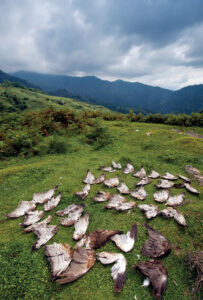Third International Scientific and Practical Conference “Eagles of the Palearctic: Study and Conservation”
Raptors Conservation. Suppl. 2. Proceedings of Conferences
The Analysis of Recorded Causes of Death of Adult Eagles in Georgia in 1973–2022
Abuladze A. (Institute of Zoology, Ilia State University, Tbilisi, Georgia)
Contact:
Aleksandre Abuladze aleksandre.abuladze@iliauni.edu.ge
Recommended citation: Abuladze A. The Analysis of Recorded Causes of Death of Adult Eagles in Georgia in 1973–2022. – Raptors Conservation. 2023. S2: 168–171. DOI: 10.19074/1814-8654-2023-2-168-171 URL: http://rrrcn.ru/en/archives/34996
Since 1973, the author has been conducting a complex study of birds in Georgia. Particular attention was paid to identifying threats and limiting factors, determining the extent and causes of death of all raptors, including eagles. All known cases were registered and, if possible, the causes were determined. In addition to the materials collected by the author together with assistants, for the collecting of statistical data regarding raptor mortality (including eagles), in 1978– 1985 and in 1990–1991 special questionnaires were prepared and distributed to all regions, autonomous republics and districts of Georgia, to regional inspectors of regional branches of the former State Nature Conservation Committee, employees of the former Department of Nature Reserves and Hunting Industry of Georgia, stuff of the former Georgian Society of hunters, regional branches of hunters and falconers societies, zoologists and conservationists working in nature reserves, universities, nature history museums, as well as to local amateur naturalists, birdwatchers and school teachers.
More than 8700 copies of questionnaires were distributed. Appeals to participate in the counting along with instructions were published in local newspapers and distributed via mass-media (radio, TV). As a result, about 520 responses were received, including detailed information on number of raptors killed by poachers, electrocuted on power lines, trapped by falconers, poisoned by chemicals, etc., altogether giving data on more than 160 death cases of nine eagle species. That was a great help for better understanding of threats and limiting factors.
The total number of adult eagles’ deaths recorded in Georgia in 1973–2022 was 441: 118 in 1973–1980, 171 in 1981–1990, 69 in 1991–2000, 56 in 2001–2011, and 27 in 2012–2022. At least 362 of recorded mortality cases, or approximately 82% of all, occurred during the autumn migration, which coincides with the hunting season in Georgia, while 27 cases (6.12%) were recorded during spring passages, 28 (6.35%) cases – during wintering, and 24 (5.44%) cases – during breeding seasons. The main cause of death for adult eagles recorded in Georgia during study has been shooting – 296 cases for 9 eagle species, which is more than 67% of the total number of registered cases.
Other recorded causes of mortality were the following: death on electricity cables due to electric shock (17 cases for 4 species), trapping and killing (5 cases for 2 species), death in traps with meat baits (5 cases for 2 species), death due of poisoning at poisoned meat baits (4 cases for 2 species), collisions with technical constructions (4 cases for 2 species), death on garbage damps due of poisoning (2 cases for 1 species), victims of prey (1 cases for 1 species), collisions with vehicles (1 cases for 1 species), unidentified reasons (106 cases for 7 species). There is no doubt that the shooting was the cause of the eagles’ deaths in those cases when it was not possible to accurately determine its cause.
More detailed summarized data on distribution of registered mortality cases of adult eagles by seasons of years as well as by regions of Georgia are presented, analyzed, and discussed. Human persecution, especially illegal shooting, should be considered as a basic threat to raptors in Georgia, including all eagle species. The highest level of illegal eagle shooting in Georgia was recorded at Black Sea coastlands, in western part of Kolkheti Lowland, in river valleys, in suburbs of large cities, and in some other areas.
If we compare the scale and causes of the eagle mortality in Georgia in different decades, then in general it should be noted that in recent years there has been a slight decrease in the number of shootings. Nevertheless, despite the legislative protection of all species of birds of prey in Georgia, shooting is still the main threat.
There are no recent data on raptor protection status from some regions of Georgia annexed by Russia – Abkhazia (from 1993) and South Ossetia (from 2008). According to the available information from these regions, the situation there is alarming.
To improve the situation with the protection of eagles in Georgia, as well as for all other raptor species, it is necessary to conduct extensive educational programs among all segments of the population, primarily among hunters.

Evidence of illegal raptor shooting along Georgia’s Black Sea coast: hunters typically remove and discard the wings, legs and heads of the birds they shoot. Photo by B. Willaert.
